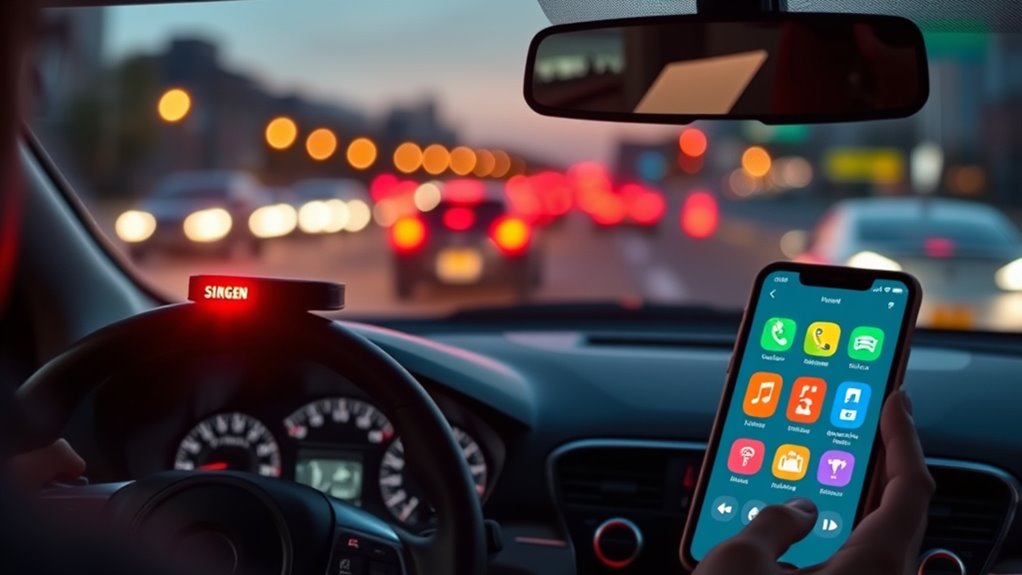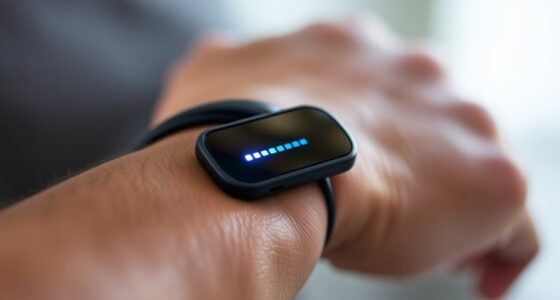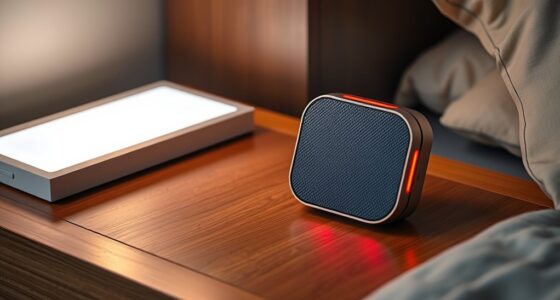Innovative apps and devices now help deaf drivers detect sirens and horns using advanced sound recognition, noise filtering, and visual alerts. Wearable tech with vibrate or musical notifications quickly inform you of hazards, while vehicle-integrated visual cues and external lights enhance safety. Tactile alerts improve driver awareness, and ongoing developments focus on smarter, reliable systems. If you want to explore how these tools can boost your safety and independence on the road, keep exploring further.
Key Takeaways
- Advanced sound recognition apps detect sirens and horns, filtering background noise for accurate alerts to deaf drivers.
- Wearable devices provide tactile alerts, such as vibrations or musical cues, for quick hazard awareness.
- Visual indicators, including HUD displays and external lights, signal emergencies and obstacles effectively.
- Integration of sensors and AI enhances real-time hazard detection and customizable alerts for increased safety.
- Standardization efforts promote the adoption of visual and tactile alert systems, improving reliability and driver confidence.
Innovative Apps for Detecting Emergency Sirens
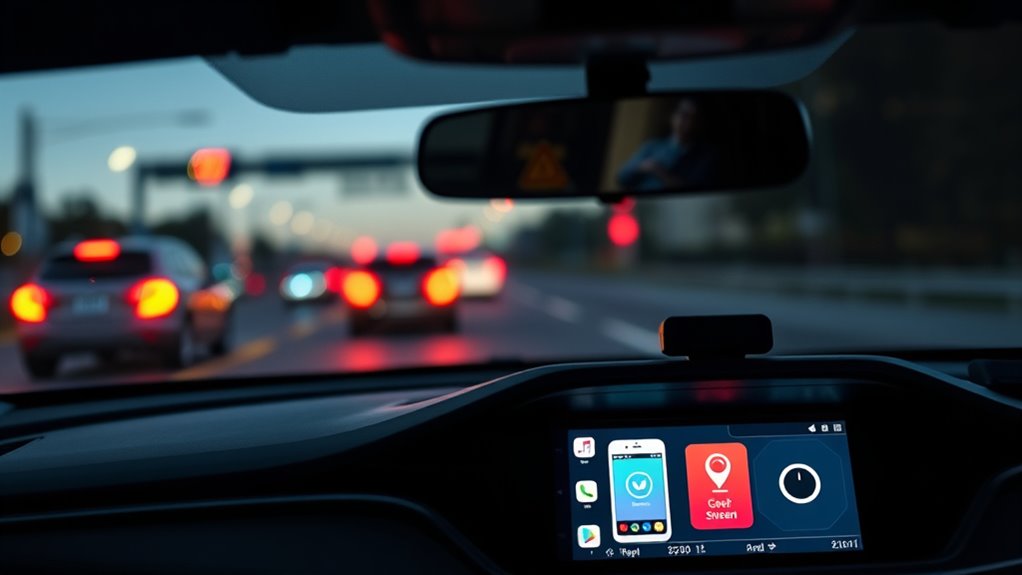
Innovative apps for detecting emergency sirens are transforming safety for deaf drivers by providing real-time alerts. These apps analyze traffic noise using advanced sound recognition technology, filtering out background noise to accurately identify sirens. As traffic noise often masks sirens, these apps serve as an essential tool for timely emergency response, alerting you instantly when sirens are nearby. By vibrate notifications or visual alerts, you stay aware of emergency vehicles even when you can’t hear horns or sirens. These apps bridge the gap created by traffic noise, markedly enhancing your ability to respond promptly and confidently in critical situations. Understanding sound recognition technology can help you better appreciate how these apps detect sirens accurately and reliably. Additionally, the integration of noise filtering algorithms ensures a higher success rate in various noisy environments. Recognizing the importance of real-time alerts can further improve your responsiveness and safety on the road. Incorporating headphone compatibility with these apps can also ensure you remain connected to alerts without missing critical sounds.
Wearable Devices That Enhance Road Safety

Wearable devices are revolutionizing road safety for deaf drivers by providing instant alerts and real-time information. These devices use musical notifications to alert you to emergency sirens, horns, or other hazards, ensuring you stay aware without relying on sound. Many models support voice command features, allowing you to control settings or get updates hands-free, keeping your focus on the road. When a siren or horn is detected, the device vibrates or plays a distinct musical notification, so you’re immediately alerted. This seamless integration of alerts helps you respond quickly and confidently, enhancing safety. Incorporating advanced detection technology can further improve the accuracy and reliability of hazard alerts. Additionally, real-time hazard detection enhances the device’s ability to identify and notify you of nearby dangers promptly, making your driving experience safer. The wearable design ensures these devices are comfortable for daily use, encouraging consistent use and maximizing safety benefits. By utilizing vibe coding techniques, these devices can deliver precise and personalized alerts tailored to individual needs, further boosting safety. Features like personalized alerts can help customize notifications based on user preferences, increasing the effectiveness of alerts. They bridge the gap between visual cues and auditory signals, making driving safer for deaf drivers everywhere.
How Vibration Alerts Improve Driver Awareness

Vibration alerts use specific patterns to grab your attention quickly, helping you stay aware of road hazards. When these alerts are customizable, you can set them to suit your preferences, making them even more effective. This combination boosts your alertness and safety while driving. Incorporating personalized alert settings can enhance the responsiveness of vibration alerts, ensuring drivers receive timely signals tailored to their environment. Additionally, advances in portable safety devices are contributing to more reliable and user-friendly alert systems. As AI safety measures continue to develop, implementing reliable alert systems becomes increasingly important for device security and driver trust. Exploring essential oils for alertness highlights natural ways to stay focused and aware during drives. Embracing Life’s Awkward Moments: Share Your Story can help normalize experiences and reduce stigma around challenges faced by deaf drivers.
Vibration Patterns Enhance Alertness
Vibration alerts play an essential role in boosting driver alertness by providing immediate, tactile feedback that’s hard to ignore. Different vibration patterns can signal various hazards, making it easier for you to recognize urgent situations quickly. Think of how musical training sharpens your sense of rhythm; similarly, distinct vibration patterns create a language your body understands instantly. This tactile feedback ensures you stay aware even when auditory cues are missed. To illustrate, here’s a quick comparison:
| Vibration Pattern | Meaning | Response Needed |
|---|---|---|
| Short pulses | Horn honk | Slow down |
| Repeated buzzes | Siren alert | Prepare to stop |
| Rapid pulses | Emergency | Immediate action |
Additionally, incorporating vibration feedback into driver safety technology can enhance overall situational awareness in various driving conditions. Incorporating tactile signals into these devices helps create a more intuitive and responsive alert system for deaf drivers. Moreover, ongoing research in haptic feedback continues to refine how these signals can be optimized for faster and more reliable recognition, leading to more effective alert mechanisms for drivers.
Customizable Alerts Increase Safety
Customizable alerts empower you to tailor your tactile feedback to your specific driving needs, substantially boosting safety. With adjustable vibration patterns and intensities, you can focus on critical signals like sirens or horns, reducing distractions. This personalization enhances driver awareness, especially for deaf drivers relying on tactile cues. Incorporating adaptive training helps you learn to interpret alerts more effectively, improving response times. Keep in mind legal considerations, such as ensuring devices meet safety regulations and won’t distract others on the road. Customization also allows you to set alerts that suit your environment and comfort, making the system more reliable and less intrusive. Additionally, understanding vehicle safety standards can help you ensure that your modifications comply with regulations and maintain overall safety. Recognizing Ford Tuning can help optimize vehicle modifications to support assistive technology integration. Understanding air quality can be beneficial for maintaining a comfortable and safe driving environment, especially when using electronic devices. Being aware of meditation techniques can help you stay calm and focused during stressful driving situations. For example, using vibration feedback settings that are not too intense can prevent discomfort during long trips. Ultimately, personalized vibration alerts help you stay safer, confident that you’ll notice important sounds through tactile signals tailored just for you.
Integration of Visual Cues With Vehicle Systems
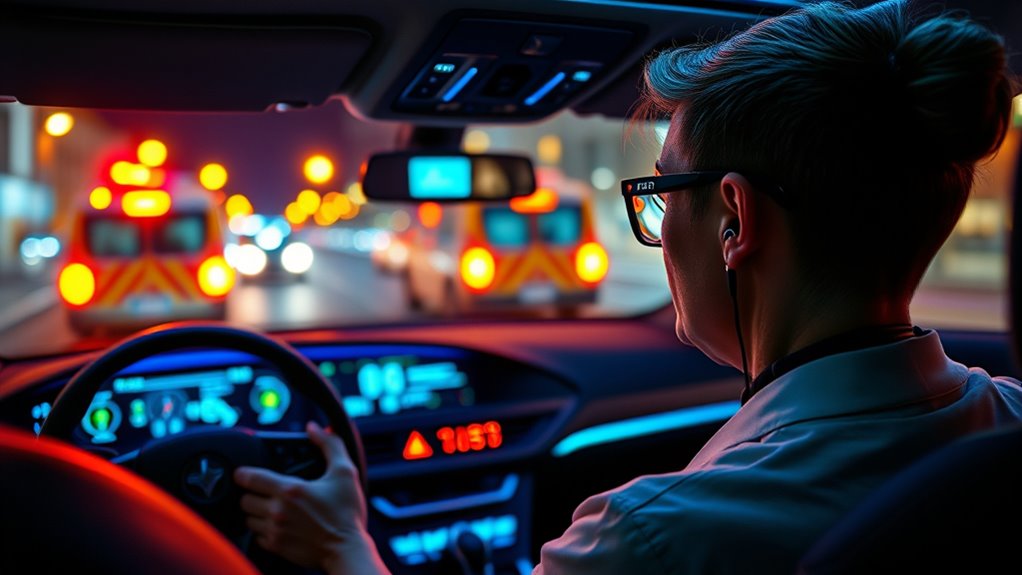
You can enhance safety by integrating visual cues directly into your vehicle systems. Features like HUD displays, external lighting indicators, and visual alerts help you stay aware of your surroundings. Exploring these options can make your driving experience safer and more accessible. Incorporating layered textures and colors can also contribute to a more inviting and comfortable environment inside your vehicle. Additionally, understanding tableware terminology and design trends can inspire interior aesthetics that promote a calming driving atmosphere.
Visual Alert Integration
Integrating visual alerts into vehicle systems guarantees that deaf drivers receive immediate and clear notifications about critical driving conditions. By combining visual cues with existing vehicle alerts, you reduce reliance on assistive hearing devices and make certain you’re promptly informed of sirens, horns, or other hazards. These alerts are designed to minimize cognitive load, allowing you to focus on the road without distraction. For example, flashing lights or dashboard indicators can signal emergencies, lane departures, or obstacles effectively. This integration improves safety by providing a seamless, non-intrusive way to stay aware of your surroundings. Ultimately, visual alert systems ensure you’re instantly aware of important sounds and signals that traditional hearing would typically provide, making driving safer and more accessible.
HUD Display Features
How can a HUD (Heads-Up Display) enhance visual communication for deaf drivers? By projecting critical alerts directly onto your windshield, a HUD ensures you don’t miss important signals like sirens or horns. This integration helps you stay aware of your surroundings without diverting your eyes from the road, reducing distractions. As driver training evolves, incorporating HUD features becomes essential, teaching new drivers how to interpret visual cues effectively. Legislation updates increasingly recognize the importance of visual alerts, encouraging automakers to adopt HUD systems that support deaf drivers. These displays can highlight upcoming hazards, navigation cues, and emergency signals, making driving safer and more accessible. With continuous advancements, HUD integration offers a crucial tool for improving situational awareness for deaf drivers on today’s busy roads.
External Lighting Indicators
External lighting indicators enhance visual communication by signaling critical information through vehicle-mounted lights that are easily visible in various conditions. These external beacons and lights provide essential visual signaling, alerting you to emergencies or hazards even when audible alerts are missed. They can be integrated with vehicle systems to activate automatically during siren or horn detection, ensuring you stay informed. The table below highlights common external lighting indicators and their functions:
| Indicator Type | Function | Visibility Conditions |
|---|---|---|
| Emergency Beacons | Signal presence of emergency | Day and night |
| Brake Lights | Indicate stopping | All weather |
| Turn Signals | Show turning intentions | Day and night |
| Hazard Lights | Warn of hazards | Poor visibility |
| Warning Lights | Alert to system faults | All conditions |
These visual cues help you navigate safely, especially in noisy environments or when hearing is impaired.
Challenges and Limitations of Current Technologies

Despite advancements, current technologies for deaf drivers still face significant challenges that limit their effectiveness. Navigation challenges remain, as devices may not always provide real-time updates or accurately detect complex road situations, making it harder to stay aware of surroundings. Communication barriers also persist; while visual alerts for sirens and horns help, they can miss subtle cues or be overwhelmed by noise, reducing their reliability. Some systems struggle with false alarms or delays, which can cause confusion or frustration. Additionally, integration issues between different devices can hinder seamless communication. Limited coverage in certain areas and dependence on sensor accuracy further restrict performance. As a result, deaf drivers still face obstacles in fully trusting these tools for safe, confident driving.
Future Developments in Hearing-Impaired Driver Support

Advancements in technology are paving the way for more reliable and integrated support systems for deaf drivers. Future developments may include smarter assistive hearing devices that seamlessly connect with vehicle systems, providing real-time alerts for sirens, horns, and other critical sounds. These devices could use AI to improve accuracy and customization, ensuring you receive timely notifications tailored to your environment. Additionally, innovative apps could integrate with vehicle dashboards or wearables, enhancing situational awareness. However, legal considerations will shape these advancements, especially regarding privacy, data security, and liability. As technology evolves, you’ll need to stay informed about regulations to guarantee compliance and safety. These developments promise a future where deaf drivers experience greater independence and confidence behind the wheel.
Frequently Asked Questions
How Do These Apps Perform in Noisy Urban Environments?
In noisy urban environments, signal detection can be challenging, but these apps are designed to overcome urban noise. They use advanced sensors and algorithms to distinguish sirens and horns from background sounds, ensuring you stay alert. You’ll find that many apps perform reliably, providing timely alerts even amid urban noise. However, the effectiveness depends on your device’s quality and the app’s sensitivity settings, so it’s worth customizing for best results.
Are There Legal Regulations for Using Such Devices While Driving?
You should know that legal compliance varies by location, so check local laws before using alert devices while driving. Many regions don’t specifically regulate these tools, but liability concerns can arise if an accident occurs and your device was a factor. It’s your responsibility to make sure your devices don’t distract you or violate traffic laws, helping you stay safe and legally protected on the road.
What Is the Battery Life of Wearable Safety Devices?
Imagine you’re using a wearable safety device that alerts you to sirens and horns. Battery longevity varies depending on usage and power management, but many devices last between 24 to 48 hours on a single charge. Effective power management features, like automatic sleep modes, help prolong battery life. Regularly charging your device ensures you’re always protected, especially during long drives, giving you peace of mind and continuous safety.
Can These Technologies Be Integrated Into All Vehicle Makes and Models?
You might wonder if these alert technologies can work with all vehicles. Vehicle compatibility and manufacturer integration vary, so not every app or device easily fits every make and model. Some manufacturers design their systems to support third-party integrations, while others don’t. To guarantee compatibility, check each device’s specifications and consult your vehicle’s manufacturer. Custom solutions or future updates could improve integration across more vehicle types.
How Accessible Are These Technologies for Drivers With Additional Disabilities?
You’ll find that assistive technology improves accessibility for drivers with additional disabilities, but barriers still exist. Some devices may not be compatible with all vehicles, creating accessibility barriers. You might need customized solutions or additional adaptations to guarantee full usability. While advancements are promising, widespread integration and affordability remain challenges. By addressing these issues, you can ensure that tech truly supports all drivers, regardless of their specific needs.
Conclusion
As a deaf driver, these innovative apps and devices are transforming road safety. Did you know that vibration and visual alerts can increase your reaction time by up to 30%? By embracing these technologies, you stay more aware of sirens and horns, helping you navigate confidently. While challenges remain, ongoing advancements promise even better support. Embrace these tools—they’re making the roads safer and more accessible for everyone.

